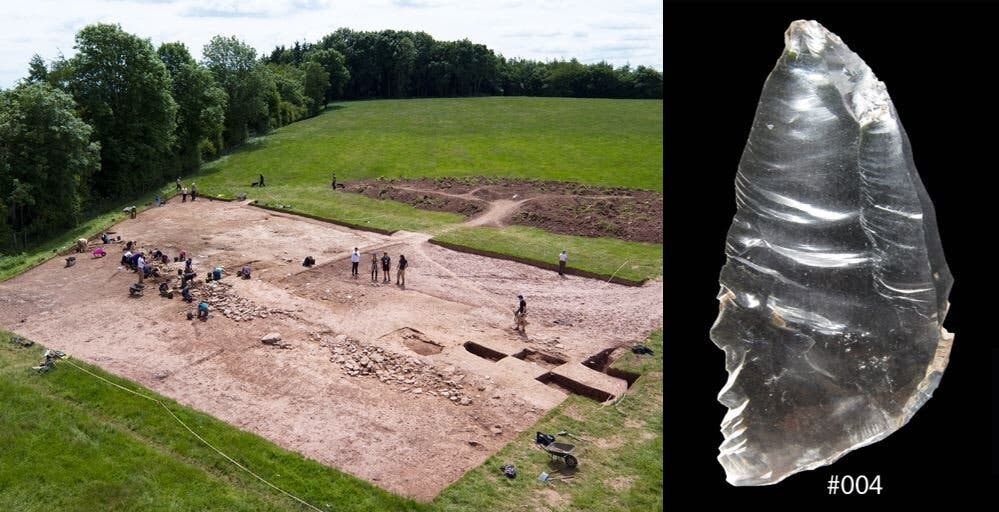Archaeologists from the University of Manchester discovered rock crystals during excavations at Dorstone Hill in England — a monumental complex from the Neolithic Period (6,000 BC to 3,000 BC). The crystals were brought to the site and knapped in a systematic way to mark burial sites and were then deposited in the Neolithic burial site.

The complex, excavated between 2011 and 2019, includes three long mounds, three timer halls and a causewayed enclosure. As well as a wide array of artefacts such as pottery, stone implements and cremated bones, the researchers uncovered rock crystal – a pure, transparent form of quartz, which forms in large six-sided crystals. By far, the quartz is the most striking find from the site.
While evidence for the use of rock crystal has been found at other prehistoric sites in the United Kingdom, only a few studies have specifically looked at how the material was used and its potential significance. Now, the team at the University of Manchester has suggested the crystals were intentionally deposited within the burial mounds.
“It was highly exciting to find the crystal because it is exceptionally rare – in a time before glass, these pieces of perfectly transparent solid material must have been really distinctive,” lead author Nick Overton said in a statement. “I was very interested to discover where the material came from, and how people might have worked and used it.”
A close look at rock crystals
People at Dorstone Hill had a lasting association with rock crystal, the researchers said. It was transported large distances to the site and worked in a systematic manner that remained a feature of local practice for generations. But it wasn’t used in any utilitarian way, it was intentionally collected and deposited in burial mounds with other artifacts and materials.
Absolutely delighted that our new paper on #Neolithic Rock Crystal from Dorstone Hill is now out #OpenAccess in Cambridge Archaeological Journal #Archaeology #Prehistory https://t.co/jZ6IznoUkz @RoviraGarcia @julesbirch72 @UoMCAHAE @UoMArchaeology @CUHistArchRel 🧵1/9 pic.twitter.com/HylnecgNFL
— Nick Overton (@ArchaeOverton) August 10, 2022
Based on the local geology, the rock crystal could have originated from a very limited number of sources, all of which are far away from the site. The researchers believe that the most likely sources are Snowdonia in north Wales or St David’s Head in southwest Wales. The material could have been used by people to demonstrate their local identities and connections with other places, they said, or could have had some spiritual meaning.
“The crystals would have looked very unusual in comparison to other stones they used, and are extremely distinctive as they emit light when hit or rubbed together and produce small patches of rainbow,” Overton said in a statement. “They would have created memorable moments that brought individuals together and forged local identities.”
One of the crystals, for example, has a small internal structure that is illuminated by a rainbow flash when rocked back and forth in the light. Another piece, a flake full of micro-cracks, shimmers with dancing lines of a rainbow as light hits the internal fracture planes within it. This added an extra dimension to the “visually arresting” character of this material.
As well as in Dorstone Hill, crystals have played a significant role in people’s lives in a large number of societies, the researchers said. Animist groups in the Amazon saw quartz as a “living rock” with special healing properties and Australian aboriginal groups understood rock crystal as “solidified light,” spiritually charged with power, for example.
“At Dorstone Hill, the working of this material, associated with dramatic places, and affording experiences of its unique transparent, refractive and triboluminescent properties, would act to disrupt everyday life, creating memorable moments for those in attendance,” the researchers wrote.
Up next, the team hopes to study materials found at other sites in the UK to discover whether people were working with this material in other ways, as well as to uncover connections and local traditions. They also want to analyze the chemical composition of the crystal to find out if they can track down its specific source.
The study was published in the Cambridge Archaeological Journal.
Was this helpful?



